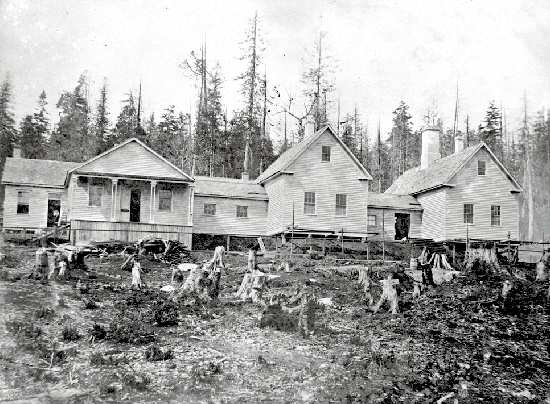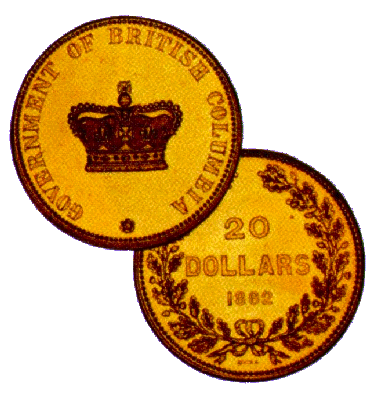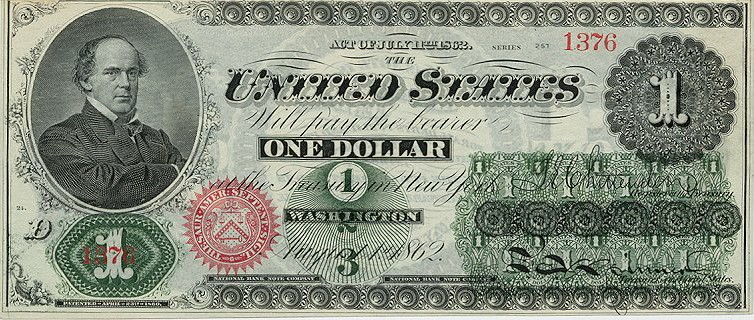
The Monashee Almanac is an online journal that shares history, mysteries and stories about early British Columbia and in particular the Monashee, Okanagan and Shuswap.
Celebrating History, Mysteries & Stories
Cashing in Pay Dirt and the Strange British Columbia Mint
A shortage of dependable currency continent-wide and gold was increasing in value.
Above: Both sides of a British Columbia twenty dollar gold pattern coin of 1862. This, and it's companion ten dollar piece, were the first gold coins struck for what is now Canada. Right: Where they were minted; the new BC coining plant in 1862 located in New Westminster.


Early Money in the Colony
Different currencies and many different values
In 1862, British Columbia and Vancouver Island were not yet part of Canada. As part of the British Empire, British Columbia traded in “sterling” the word used to describe British currency.
There was an extreme shortage of coined money and the miners had great difficulty exchanging their gold for coins.
Gold dust was being used as a medium of exchange in the colonies of Vancouver Island and British Columbia following the discovery of gold in the Fraser River in the late 1850s. The use of gold dust was open to abuse, since the dust was of uncertain quality and had to be weighed. In 1861, the Colony of British Columbia issued Treasury notes, first seemingly in pounds and, subsequently, in dollars. These notes, which were used to finance public works, circulated freely, given a shortage of minted coins.
While urgent requests were made to Great Britain to supply the colony with quantities of hard currency, only a comparative trickle of silver coins arrived. The colonial government notes, brought some temporary relief, they were all eventually redeemed by the government.
Then there was an even bigger currency problem emerging. In 1862, the American Civil War began to affect currency in the United States. As the finances of the Union government deteriorated, U.S. banks suspended the convertibility of their notes into gold, and the government suspended the right to convert U.S. Treasury notes (government-issued paper money) into gold.
There was now a shortage of dependable currency continent-wide and gold was increasing in value. By 1862, this brought about a nervousness that US forces might try to occupy gold producing areas in an effort to firm up the US Greenback.
Governor Douglas was forced by the extent of the currency crisis to consider issuing colonial coins. He sought permission from Her Majesty's Government in November 1861 to set up a coining plant in connection with the Assay Office that had previously been established in New Westminster in 1860. The colonial assayer, Francis George Claudet, was sent to San Francisco to purchase the necessary machinery. The dies for the ten and twenty dollar pieces were ordered from a Mr. Wagner of Vanderslices Silver Manufactory. These were engraved by Albert Küner of San Francisco. Silver die test specimens were struck in San Francisco and were sent along with the dies. Years later those original wax impressions that Küner made were destroyed in the San Francisco fire of 1906.
Sometime during the spring of 1862, Governor Douglas changed his mind about coining currency, his reasons are unknown, but nevertheless the Treasurer of B.C., William Driscoll Gosset, went ahead with the plans and set up the coining plant with the newly arrived equipment in June 1862.
A few sample ten dollar coins were struck and some were sent to Douglas with the intention of sending them to the International Exhibition being held in London that year.
At first Douglas said no, and was most likely quite surprised since he had not given final permission for the mint to be set up and was no longer in favour of the plan. Gosset prevailed and finally got Douglas to agree to allow eighteen $10 and ten $20 pieces to be struck for the exhibition. The coins were sent to the Commissioner for B.C in London to be shown at the exhibition, then to be melted down for bullion. Gosset was permitted to frame two specimens as Mint souvenirs. Douglas then ordered the plant to be shut down, thus ending B.C.'s hope for a mint and a coinage made from her own precious metal.
The few specimens of these coins known today were probably test pieces purchased by some senior members of the government as souvenirs. These patterns could not be called official coinage as no permission had been given by the Crown to strike coins in British Columbia. Three, possibly four, of the $10 and five, possibly six, of the $20 are known to have survived. Of the silver die test pieces, five of the $10 and 4 of the $20 are known to exist. The gold set in the British Museum is most likely the set Gosset had framed.
The B.C. Provincial Archives has a set of both coins in gold and silver, of which the somewhat battered $10 gold coin was once worn as a watch fob by B.C. Premier John Robson. At one time the late King Farouk of Egypt was known to have had one of the $20 coins. One collector, Virgil Brand, had seven of the B.C. coins, gold and silver, in his collection.
Source:
The above article is based on a much longer article by Leslie Hill which in turn is based on the B.C. Archives memoir no. VII, "The Assay Office and the proposed mint at New Westminster", by Robie L. Reid. Additional material was supplied by R. Greene.
By 1862 the new colony of British Columbia was in chaos, miners continued to flood into the remote parts of the colony including Cherry Creek. If you were a miner and you had extracted gold out of the creek, just where would you cash it in?
Sidebar:
Origin of “Dollar” and “Pound”
The word “dollar” originates from the German word “thaler”, the name given to a silver coin first minted in Joachimsthal, Bohemia in 1519.
“Cent” comes from the Latin centum, meaning hundred. The origin of the dollar sign “$” is obscure but is widely believed to have been derived from a symbol denoting Spanish pesos.
“Pound” and its symbol “£” come from the Latin libra, the value of a troy pound of silver.
“Shilling” is believed to come from the old Scandinavian word skilling, meaning division. Its symbol “s.” refers to the Latin solidus, a Roman coin.
“Pence,” or pennies, comes from the Old English word pennige. Its symbol “d.” refers
to the denarius, another Roman coin.
Before decimalization, one pound was equal to 20 shillings, with one shilling equal to 12 pence.
According to the Bank of Canada….
In the 1800’s, Canadian bank notes, denominated in dollars, were widely accepted and circulated freely in the United States. Had Canada adopted the sterling standard, this circulation would have been lost, to the detriment of Canadian banks.
Political union of Upper and Lower Canada to create the Province of Canada on February 10, 1841 led to a new standardized rating for coins in the newly united province that took effect in April 1842. The British gold sovereign was valued at one pound, four shillings, and four pence in local currency, while the US$10 gold eagle was valued at two pounds, ten shillings.
Both coins were considered legal tender. Spanish (including Spanish colonial) and U.S. silver dollars with a minimum weight of 412 grains of gold were also made legal tender with a value of five shillings and one pence.
In 1862, British Columbia and Vancouver Island were not yet part of Canada. As part of the British Empire, British Columbia traded in “sterling” the word used to describe British currency. Pounds, shillings, and pence were used as the unit of account in the British colonies of North America up until the middle of the nineteenth century. But given the scarcity of British coins, and the prevalence and wide acceptance of Spanish silver dollars, it became increasingly difficult to maintain a currency system based on sterling.
The introduction of the U.S. dollar (modeled on the Spanish dollar) in the United States in 1792 began to compete against British sterling and by 1862 Canada had also introduced a bank note called a “dollar”. As a result, growing trade and financial links between the frontier regions and Upper and Lower Canada and the United States during the first half of the nineteenth century, favoured the use of dollars over sterling. The same was true for the colonies of Vancouver Island and British Columbia on the west coast which had its own trade routes along the Pacific and emanating from San Francisco during the late 1850s and early 1860s.
In 1862, the American Civil War began to affect currency in the United States which then impacted the whole continent. When the US greenback was introduced, it flooded currency markets and depreciated relative to gold and against other currencies, including the Canadian dollar, which remained on the gold standard.
The weakness in the greenback undoubtedly reflected the rapid expansion of the U.S. note issue from $150 million in early 1862 to $450 million by March 1863. Fluctuations in its value also reflected the military and political fortunes of the Union government and, hence, the expected likelihood that the government would eventually be able to redeem the greenbacks in gold.
The greenback tended to strengthen on news of Union victories, such as the Battle of Gettysburg in 1863, and weakened on Union reversals. It reached its nadir during the summer of 1864, when the Union government, in a move against speculators, temporarily shut down gold trading for two weeks in late June, followed in early July by Confederate advances towards Baltimore and Washington and raiding operations in Pennsylvania.
Based on available information, the U.S. greenback fell from close to parity against the Canadian dollar in early 1862 to less than 36 Canadian cents (or Can$1=US$2.78) on Monday, 11 July 1864. This represents the all-time peak for the Canadian dollar in terms of its U.S. counterpart.
Inflation and Early
Money in the Colony
Many different currencies
and many different values

Above: An 1862 US "Greenback"